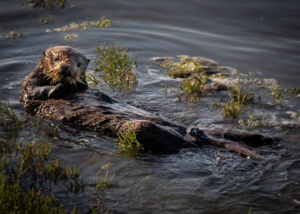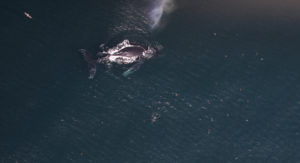In September, a surfer named Nick Ericksen was catching some waves at Steamer Lane in Santa Cruz when a creature emerged from the depths and grabbed his board. To his relief, the creature wasn’t a shark, but a cute, fluffy sea otter. And this otter had an agenda. In a video of the encounter captured by a shoreside onlooker, Ericksen relinquishes the board to the sea otter and struggles to get it back. The otter curls up on Ericksen’s board and, like a true Santa Cruz local, proceeds to ride a few waves.
“It climbed on and made itself at home,” Ericksen told CNN.
As it turned out, this otter was a known otter—a 4-year-old female, born in captivity, that frequents the area.
Although around 70 otters are known to hang out along the Santa Cruz coastline, along with surfers, kayakers, and others playing at the shore, conflicts between otters and humans are rare. California sea otters, a federally protected endangered species, are usually shy of humans. But this particular otter was different—she had been seen approaching surfers and kayakers in the area. Why?
“It’s possible that she was fed by someone in the wild, which could create a positive association with people,” said Colleen Young, an environmental scientist with the California Department of Fish and Wildlife. “It’s also possible she was experiencing hormonal surges that caused a change in her behavior.” October is the start of the California sea otter’s peak pupping season, although it is unknown if this otter was pregnant at the time.
While scientists know very little about how hormonal surges influence otter behavior, they do know that feeding wild sea otters causes them to lose their natural fear of humans. Once habituated to us, otters are far more likely to engage in risky behaviors like surfboard stealing—“a dangerous situation for both otters and people,” says Young. “Sea otters have very strong jaws and very sharp teeth. A bite from a sea otter can do a lot of damage. Also, sea otters can carry diseases, some of which are transferable to people.” These include the pathogens causing brucellosis, toxoplasmosis, and coccidioidomycosis, which is called valley fever in humans, Young said.
Getting too close to people can also have consequences for otters. The California Department of Fish and Wildlife is obligated to remove sea otters from the wild if they pose a risk to public safety. In fact, this sea otter’s own mother was brought to the Marine Wildlife Veterinary Research Center in Santa Cruz several years ago for exactly this reason.
That’s why the surfboard-stealing sea otter was born in captivity. Although she was returned to the wild once old enough, this young otter may end up back in captivity if she gets into any more trouble.
The California Department of Fish and Wildlife has been keeping a watchful eye on the otter since the incident. A spokesperson for the agency said that while this sea otter’s behavior hasn’t yet warranted her removal from the wild, they did try to relocate her a little ahead of schedule to her wintering grounds down south, where there are far fewer surfers. That attempt, however, failed—the otter got away. Officials instead hazed the otter by making loud noises. Since then, she hasn’t shown any further interest in people or surfboards. The agency’s plan to relocate the otter has been on hold for now, pending the otter’s continued good behavior. If all goes well, the otter will continue foraging, grooming, resting, and generally vibing in Santa Cruz for the next few weeks before heading to her wintering grounds down south.
California sea otters, also known as southern sea otters (Enhydra lutris nereis), are a federally endangered species, with only around 3,000 individuals spread across the state. The state was once home to hundreds of thousands of otters, but the species was hunted for their luxurious fur to near-extinction between the mid-1700s and 1911. Thanks to federal protections and conservation programs, their numbers are slowly creeping back up, and the benefits of their return are already evident.

California sea otters play a fundamental role in the ecological health of California’s nearshore ecosystems, because they are sea-urchin-eating machines. By keeping urchin populations in check, sea otters keep California’s kelp forests healthy. Without them, the urchins would wipe out the kelp, which has happened in many parts of California.
To ensure that this sea otter gets to continue living its life peacefully in the wild, experts said, people sharing the water with her should give her space and, as Erickson did, discourage her from interacting with them if she approaches.
In the video, spectators laugh and heckle Ericksen as he splashes water on the animal, trying to get his board back. The otter, unperturbed, tears into his surfboard with its mighty teeth, which are normally used to crack sea urchin shells and pry clams open. It only hops off when another surfer comes to Ericksen’s aid.
The surfers managed to help Ericksen get his board back to shore, but not before they were briefly chased by the otter.
“It was like a scary movie,” recalled Ericksen.
“In this case, the surfer was behaving responsibly,” says Gena Bentall, director and senior scientist with Sea Otter Savvy, an organization that works to reduce human-caused disturbance to sea otters and promote responsible wildlife viewing.
According to Bentall, allowing a sea otter to climb atop your surfboard, paddleboard or kayak will only reinforce an otter’s mistaken belief that humans don’t pose a threat. As lucky as some might feel to have a sea otter interact with them, such situations are “not an adorable moment to be recorded for posterity and made into a viral video,” Bentall says. “It’s a dangerous situation for the person, and for the sea otter.”



-300x198.jpg)

